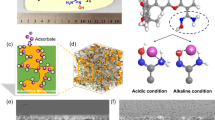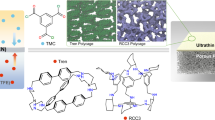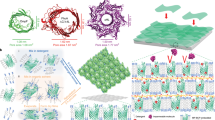Abstract
Chemical separations represent a large portion of the cost of bringing any new pharmaceutical product to the market. Membrane-based separation technologies1,2, in which the target molecule is selectively extracted and transported across a membrane, are potentially more economical and easier to implement than competing separations methods; but membranes with higher transport selectivities are required. Here we describe an approach for preparing highly selective membranes which involves immobilizing apoenzymes within a microporous composite. The apoenzyme selectively recognizes its substrate molecule and transports it across the composite membrane, without effecting the unwanted chemical conversion of the substrate molecule to product. We demonstrate this approach using three different apoenzymes. Most importantly, it can be used to make enantioselective membranes for chiral separations, one of the most challenging and important problems in bioseparations technology. We are able to achieve a fivefold difference between the transport rates of D- and L-amino acids.
This is a preview of subscription content, access via your institution
Access options
Subscribe to this journal
Receive 51 print issues and online access
$199.00 per year
only $3.90 per issue
Buy this article
- Purchase on Springer Link
- Instant access to full article PDF
Prices may be subject to local taxes which are calculated during checkout







Similar content being viewed by others
References
Baker, R. W.et al. Membrane Separation Systems(Noyes Data Corp., New Jersey, (1991).
Winston, W. H. & Sirkar, K. K. Membrane Handbook(Van Nostrand Reinhold, New York, (1992)).
Stein, W. D. The Movement of Molecules Across Cell Membranes(Academic, New York, (1967)).
Scholander, P. F. Oxygen transport through haemoglobin solutions. Science 131, 585–590 (1960).
Chen, X., Nishide, H. & Tsuchida, E. Analysis of facilitated oxygen transport in a liquid membrane of haemoglobin. Bull. Chem. Soc. Jpn 69, 255–259 (1996).
Rethwisch, D. G., Yi, G., Subramanian, A. & Dordick, J. S. Enzyme-facilitated transport and separation of organic acids through liquid membranes. J. Am. Chem. Soc. 112, 1649–1650 (1990).
Rethwisch, D. G., Parida, S., Yi, G. & Dordick, J. S. Use of alcohols as cosolvents in enzyme-facilitated transport of organic acids through liquid membranes. J. Membr. Sci. 95, 83–91 (1994).
Dordick, J. S. Biocatalysts in Industry 311–325 (Plenum, New York, (1989)).
Stanley, T. J. & Quinn, J. A. Phase transfer catalysis in a membrane reactor. Chem. Eng. Sci. 42, 2313–2324 (1987).
Matson, S. L. & Lopez, J. L. Frontiers in Bioprocessing(CRC, Boca Raton, (1989)).
Parthasarathy, R. V. & Martin, C. R. Synthesis of polymeric microcapsule arrays and their use for enzyme immobilization. Nature 369, 298–301 (1994).
Nishizawa, M., Menon, V. P. & Martin, C. R. Metal nanotubule membrane with electrochemically switchable ion-transport selectivity. Science 268, 700–702 (1995).
Martin, C. R. Nanomaterials: A membrane-based synthetic approach. Science 266, 1961–1966 (1994).
Martin, C. R. Membrane-based synthesis of nanomaterials. Chem. Mater. 8, 1739–1746 (1996).
Penner, R. M., Van Dyke, L. S. & Martin, C. R. Electrochemical evaluation of charge transport rates in polypyrrole. J. Phys. Chem. 92, 5274–5282 (1988).
Noble, R. D., Koval, C. A. & Pellegrino, J. J. Facilitated transport membrane systems. Chem. Eng. Prog. 85, 58–70 (1989).
Noble, R. D. Generalized microscopic mechanism of faciitated transport in fixed carrier membranes. J. Membr. Sci. 75, 121–129 (1992).
Lakshmi, B. B. Unpublished results.
Borman, S. Chirality emerges as key issue in pharmaceutical research. Chem. Eng. News 68, 9–12 (1990).
Stinson, S. C. Chiral drugs. Chem. Eng. News 73, 44 (1995).
Collins, A. N., Sheldrake, G. N. & Crosby, J. Chirality in Industry(Wiley & Sons, Chichester, (1992)).
Dixon, M. & Kleppe, K. D-amino acid oxidase-specificity, competititve inhibition and reaction sequence. Biochim. Biophys. Acta 96, 368–382 (1965).
Higuchi, A., Ishida, Y. & Nakagawa, T. Surface modified polysulfone membranes: separation of mixed proteins and optical resolution of tryptophan. Desalination 90, 127–136 (1993).
Higuchi, A., Hara, M., Horiuchi, T. & Nakagawa, T. Optical resolution of amino acids by ultrafiltration membranes containing serum albumin. J. Membr. Sci. 93, 157–164 (1994).
Yoshikawa, M., Izumi, J., Kitao, T., Koya, S. & Sakamoto, S. Molecularly imprinted polymeric membranes for optical resolution. J. Membr. Sci. 108, 171–175 (1995).
Maruyama, A.et al. Enantioselective permeation of α-amino acid isomers through poly(amino acid) derived membranes. Macromolecules 23, 2748–2752 (1990).
Kakuchi, T., Takaoka, T. & Yokota, K. Polymeric chiral crown ethers VI. Optical resolution of α-amino acid by polymers incorporating 1,3,4,6-di-O-benzylidine-D-mannitol residues. Polym. J. 22, 199–205 (1990).
Parthasarathy, A., Brumlik, C. J., Martin, C. R. & Collins, G. E. Interfacial polymerization of thin polymer films onto the surface of a microporous hollow fiber membrane. J. Membr. Sci. 94, 249–254 (1994).
Jensen, R. D., Gill, S. C., Pardi, A. & Polisky, B. High resolution molecular discrimination by RNA. Science 263, 1425–1429 (1994).
Boyer, P. D. The Enzymes(Academic, New York, (1975)).
Worthington, C. C. Worthington Manual(Worthington Biochemical Corp., New Jersey, (1988)).
Acknowledgements
This work was supported by the US NSF and the US Office of Naval Research. We thank C. A. Koval for discussions.
Author information
Authors and Affiliations
Author notes
Correspondence and requests for materials should be addressed to C.R.M.
Rights and permissions
About this article
Cite this article
Lakshmi, B., Martin, C. Enantioseparation using apoenzymes immobilized in a porous polymeric membrane. Nature 388, 758–760 (1997). https://doi.org/10.1038/41978
Received:
Accepted:
Issue Date:
DOI: https://doi.org/10.1038/41978
This article is cited by
-
Combined “post-infiltration, subsequent photochemical cross-linking” and “cross-linking and selective etching” strategies to fabricate nanoporous layer-by-layer assembled multilayers
Colloid and Polymer Science (2017)
-
Preparation of Electrically Conductive Polymeric Membranes
Journal of Electronic Materials (2015)
-
Methods for separation of organic and pharmaceutical compounds by different polymer materials
Korean Journal of Chemical Engineering (2014)
-
Single-molecule transport across an individual biomimetic nuclear pore complex
Nature Nanotechnology (2011)
-
Artificial nanopores that mimic the transport selectivity of the nuclear pore complex
Nature (2009)
Comments
By submitting a comment you agree to abide by our Terms and Community Guidelines. If you find something abusive or that does not comply with our terms or guidelines please flag it as inappropriate.



